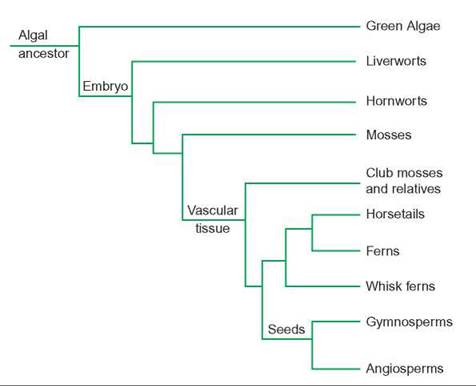CONCEPTS IN BIOLOGY
PART V. THE ORIGIN AND CLASSIFICATION OF LIFE
22. The Plants Kingdom
22.3. The Evolution of Plants
At one time, all life was aquatic. Therefore, it is logical to look for the ancestors of plants among the aquatic, photosynthetic algae. Most scientists feel that the ancestor of plants was a freshwater member of the green algae. The strongest evidence for this is that green algae have the same kinds of chlorophyll (chlorophyll a and chlorophyll b) and the same kinds of chloroplasts as plants. Comparison of the DNA of plants and green algae also supports this conclusion. The evolution of plants shows two general trends. One is toward greater specialization for living in a dry environment; the other is toward a more prominent role for the sporophyte generation in the life cycle.
The most primitive plants lack vascular tissue to help carry water. Vascular tissue consists of specialized cells arranged end to end that carry water and nutrients from one place to another. Because nonvascular plants lack vascular tissue, most are limited to moist habitats. The more advanced vascular plants have specialized cells that help transport water and other materials throughout the plant. A second major development that allowed advanced plants to exploit terrestrial habitats was the evolution of seeds that could resist drying.
In the more primitive plants, the gametophyte generation is the more conspicuous, and long-lived (dominant) generation, whereas, in more advanced groups, the sporophyte generation is dominant. The taxonomy of plants is based on these trends (figure 22.3). Subsequent sections will discuss the major groups of plants and show how life cycles and the capacity to live in a dry environment evolved.

FIGURE 22.3. The Evolution of Plants
The evolution of plants involves specializations for living on land and changes in the way they reproduce. Plants differ from their algal ancestors in that they have a multicellular immature stage known as an embryo. Vascular tissue and seeds were important evolutionary steps that allowed plants to be successful away from moist habitats.
22.3. CONCEPT REVIEW
5. Why are green algae considered to be the ancestors of plants?
6. How does the significance of the sporophyte generation change with the evolution of advanced plants?